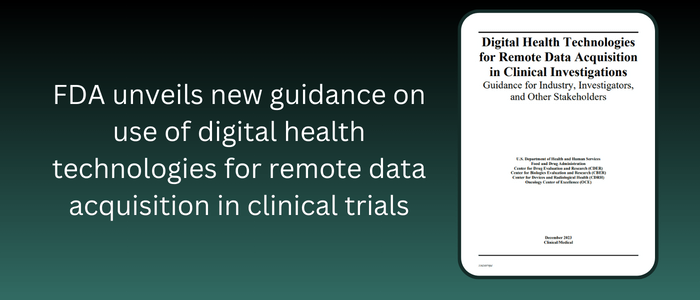FDA unveils new guidance on use of digital health technologies for remote data acquisition in clinical trials

US FDA has released a new guidance document, titled, ‘Digital Health Technologies for Remote Data Acquisition in Clinical Investigations’, which outlines how developers and researchers can leverage digital health technologies (DHTs) to collect data remotely from participants in clinical trials. This policy shift aims to streamline clinical research, improve patient experience, and accelerate the development of safe and effective medical products.
FDA has issued a final guidance document outlining how developers and researchers can leverage diverse DHTs, including continuous glucose monitors, wearable heart rate trackers, and mobile symptom tracking apps, to remotely collect data from participants in clinical trials. This move seeks to boost patient convenience, reduce travel burden for trial participants, and personalize research engagement. Published in December 2023, the new guidance outlines how participants, researchers, and sponsors can utilize DHTs for this purpose.
You may also be interested in: Infographic: Milestones in the FDA’s Real-World Evidence activities
Emphasizing the importance of using suitable technologies for reliable data collection, the guidance outlines steps for selecting and validating fit-for-purpose DHTs. Regulatory compliance and data security remain crucial aspects throughout the process. DHTs, ranging from sophisticated medical devices to simple symptom-tracking apps, can leverage existing infrastructure like smartphones and networks. They enable a shift from episodic clinic visits to continuous or frequent data capture across diverse settings, from homes to workplaces, providing a more comprehensive view of participant experiences and outcomes for a deeper understanding of treatment effects in real-world contexts.
Covering a range of considerations, the document addresses critical aspects including:
- Selection of fit-for-purpose DHTs ensuring reliable data collection and suitability for use in clinical investigations.
- Description of DHTs in regulatory submissions.
- Verification and validation of DHTs for use in clinical investigations.
- The use of DHTs to collect data for trial endpoints.
- Identification and management of risks associated with DHT implementation in clinical contexts.
- Retention and protection of data collected by DHTs.
- Clarification of roles and responsibilities for sponsors and investigators regarding DHT implementation in clinical trials.
The document highlights how DHTs can be invaluable in gathering real-world evidence, “Compared to intermittent trial visits, the use of DHTs to remotely collect data from trial participants may allow for more frequent or continuous data collection. This may provide a broader picture of how participants feel or function in their daily lives.”
DHTs can therefore provide researchers with richer insights into participants’ daily experiences by capturing subtle fluctuations in symptoms, activity levels, and well-being in natural environments, as well as allowing the participation of previously underrepresented populations, “Increasing access to and use of DHTs in clinical trials can potentially enable the inclusion of diverse and underrepresented populations by facilitating decentralized clinical trials.”
This final guidance builds upon the draft issued in December 2021, providing clarity and structure for researchers seeking to integrate DHTs into their clinical investigations. The FDA’s adoption of innovative technologies like DHTs aligns with the evolving landscape of healthcare research, fostering enhanced data collection, streamlined trials, and ultimately, faster development of safe and effective medical products.
Want regular updates on the latest real-world evidence news straight to your inbox? Become a member on The Evidence Base® today>>>






